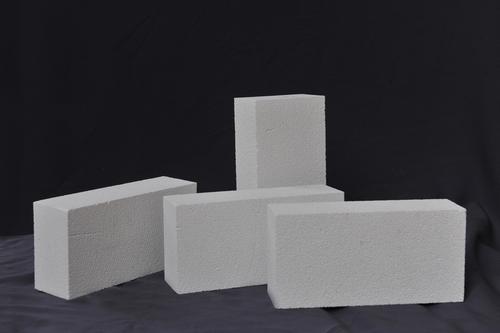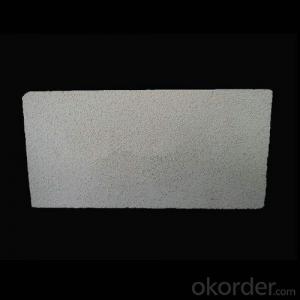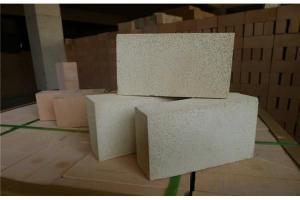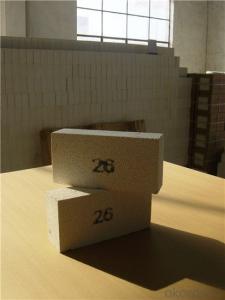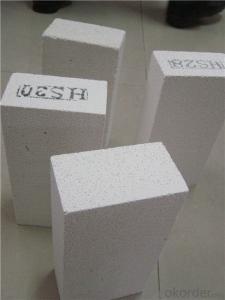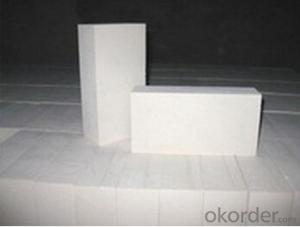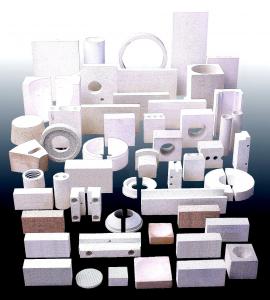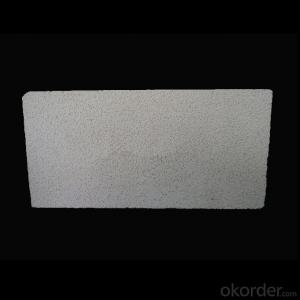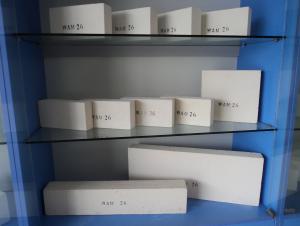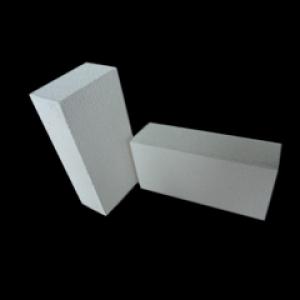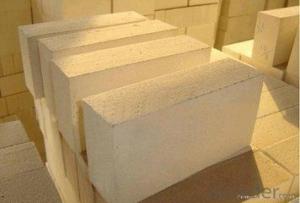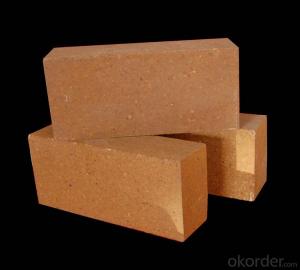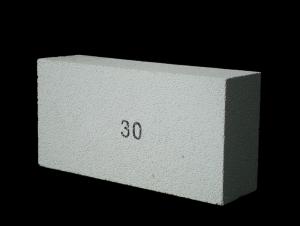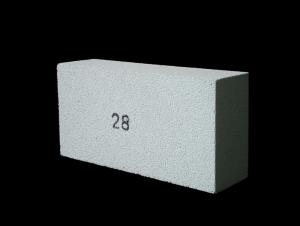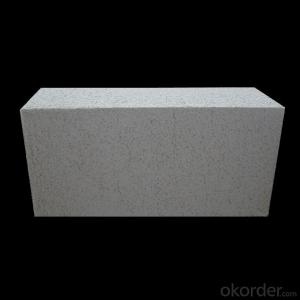Insulating Fire Brick - High-Quality Thermal Insulation Solution
- Loading Port:
- China Main Port
- Payment Terms:
- TT OR LC
- Min Order Qty:
- -
- Supply Capability:
- -
OKorder Service Pledge
Quality Product, Order Online Tracking, Timely Delivery
OKorder Financial Service
Credit Rating, Credit Services, Credit Purchasing
You Might Also Like
General Information
CMAX insulating firebricks are classified under temperature between 1300℃ to 1700℃, manufactured from high purity alumina clay.
Feature
Light weight and low thermal conductivity
Low heat storage
Low iron and impurities
High thermal shock resistance
Application
CMAX insulating firebricks can be used as a hot face lining directly exposed to the heat or as a backup insulation layer in iron and steel mills, non-ferrous foundries, petrochemical, ceramic, glass.
- Q: Are insulating fire bricks resistant to carbon monoxide attack?
- Yes, insulating fire bricks are resistant to carbon monoxide attack. These bricks are designed to withstand high temperatures and are made from materials that have low thermal conductivity. This makes them highly resistant to chemical reactions, including carbon monoxide attack.
- Q: Are insulating fire bricks resistant to acid attack?
- Insulating fire bricks are known for their resistance to acid attack. They are manufactured using durable materials that can withstand high temperatures and offer excellent insulation properties. These bricks are typically composed of lightweight refractory materials like alumina, silica, and other refractory oxides, which are renowned for their ability to resist chemical corrosion, including acids. Nevertheless, it is crucial to acknowledge that the acid resistance of insulating fire bricks can vary depending on their specific composition and manufacturing process. Some bricks may exhibit higher resistance to acids than others. Therefore, it is advisable to consult the manufacturer or supplier for detailed information regarding the acid resistance of their insulating fire bricks. Generally, insulating fire bricks are widely used in various applications where they may encounter acids, such as industrial furnaces, kilns, and high-temperature environments. They are valued for their durability and capacity to withstand harsh chemical surroundings, including acid exposure. However, it is always essential to consider the precise chemical composition and concentration of the acids involved, as well as the temperature conditions, to determine the suitability of insulating fire bricks for a particular application.
- Q: Can insulating fire bricks be used in heat treatment furnaces?
- Indeed, heat treatment furnaces can make use of insulating fire bricks. These bricks are specifically engineered to possess a low thermal conductivity, enabling them to endure elevated temperatures while minimizing the dissipation of heat. This quality renders them ideal for deployment in heat treatment furnaces, where the preservation of a stable temperature is vital for the triumphant execution of the heat treatment procedure. Moreover, insulating fire bricks exhibit exceptional insulating attributes, thereby curtailing energy usage and enhancing the overall efficiency of the heat treatment furnace. Consequently, the utilization of insulating fire bricks in heat treatment furnaces is a prevalent practice across diverse industries.
- Q: What industries commonly use insulating fire bricks?
- Insulating fire bricks are commonly used in various industries where high temperature insulation is required. Some of the industries that commonly use insulating fire bricks include: 1. Steel industry: Insulating fire bricks are used to line the furnaces, kilns, and other high-temperature equipment in steel manufacturing plants. They provide excellent insulation, reducing heat loss and improving energy efficiency. 2. Glass industry: In glass manufacturing facilities, insulating fire bricks are used to line the furnaces and ovens where the glass is melted and molded. These bricks help maintain high temperatures while minimizing heat loss, ensuring efficient and consistent production. 3. Ceramic industry: Insulating fire bricks are used in ceramic kilns and pottery ovens, providing thermal insulation to maintain the desired temperature for clay and ceramic products. They help conserve energy and optimize firing processes. 4. Cement industry: Cement kilns require high-temperature insulation to efficiently produce cement. Insulating fire bricks are used to line the kilns, reducing heat loss and improving thermal efficiency. 5. Foundry industry: Insulating fire bricks are used in foundries to line the melting furnaces and ovens used for metal casting. They help retain heat, ensuring consistent and efficient melting of metals. 6. Power generation industry: Insulating fire bricks are used in boilers, furnaces, and incinerators in power plants. These bricks provide thermal insulation, preventing heat loss and improving the overall efficiency of power generation processes. 7. Petrochemical industry: In refineries and chemical processing plants, insulating fire bricks are used to line equipment such as reactors, furnaces, and ovens. They provide insulation to withstand high temperatures and harsh chemical environments. 8. Pharmaceutical industry: Insulating fire bricks are used in pharmaceutical manufacturing facilities to line the ovens and dryers used for various processes. These bricks ensure precise temperature control and energy efficiency. Overall, insulating fire bricks find applications in industries where high-temperature insulation is crucial for efficient and cost-effective operations.
- Q: How do insulating fire bricks affect the overall insulation properties of a structure?
- Insulating fire bricks play a vital role in enhancing the insulation properties of a structure. These bricks are specifically designed to have low thermal conductivity, enabling them to effectively resist heat transfer. Consequently, they act as a barrier, preventing heat from escaping during cold weather and blocking external heat intrusion during hot weather. The utilization of insulating fire bricks significantly improves the overall thermal insulation of a structure. These bricks possess high porosity and low density, allowing them to trap air within their structure. This trapped air acts as an exceptional insulator, creating a thermal barrier that minimizes heat transfer through conduction, convection, and radiation. Consequently, the heat loss or gain through the walls, floors, and roofs of a building is notably reduced. Furthermore, insulating fire bricks exhibit excellent refractory properties, enabling them to withstand high temperatures without deforming or deteriorating. This characteristic is crucial in applications where the structure is exposed to extreme heat, such as industrial furnaces or kilns. By maintaining their structural integrity under high temperatures, these bricks ensure that the insulation properties of the structure remain intact even in challenging environments. Overall, the use of insulating fire bricks has a positive impact on the insulation properties of a structure. They effectively reduce heat transfer, conserve energy, and maintain a comfortable indoor environment. Additionally, their durability and resistance to high temperatures make them a dependable choice for insulation in various industrial and residential applications.
- Q: Can insulating fire bricks be used in the construction of blast furnaces?
- Insulating fire bricks can indeed be utilized in the construction of blast furnaces. To maintain high temperatures, blast furnaces necessitate insulation, and insulating fire bricks offer exceptional thermal insulation properties. These bricks are crafted from lightweight materials like clay and alumina, which possess the ability to endure high temperatures without melting or deteriorating. With their low thermal conductivity, they effectively minimize heat loss and conserve energy within the blast furnace. Moreover, insulating fire bricks exhibit strong resistance to chemical reactions, rendering them suitable for the harsh conditions found in blast furnace environments. All in all, the insulation capabilities and heat-resistance of insulating fire bricks make them the preferred choice for constructing blast furnaces.
- Q: Can insulating fire bricks be used for insulation in refractory lining repair?
- Yes, insulating fire bricks can be used for insulation in refractory lining repair. Insulating fire bricks are made from lightweight materials that have excellent thermal insulation properties, making them ideal for use in high-temperature applications such as furnaces, kilns, and other refractory lining structures. These bricks have low thermal conductivity and high resistance to thermal shock, allowing them to effectively insulate and protect the refractory lining from heat, preventing heat loss and reducing energy consumption. Moreover, insulating fire bricks are easy to install and replace, making them a cost-effective choice for refractory lining repair.
- Q: Can insulating fire bricks be used for insulation in heat exchangers?
- Yes, insulating fire bricks can be used for insulation in heat exchangers. Insulating fire bricks are made from a lightweight refractory material that has excellent thermal insulation properties. They have low thermal conductivity, which means they can effectively reduce heat transfer from one side of the heat exchanger to the other. This helps to maintain the desired temperature within the heat exchanger and prevents heat loss to the surroundings. Additionally, insulating fire bricks are resistant to high temperatures and can withstand thermal shocks, making them suitable for the harsh conditions often found in heat exchangers. Overall, using insulating fire bricks for insulation in heat exchangers can improve energy efficiency, reduce heat loss, and enhance the overall performance of the system.
- Q: What is the maximum temperature range of high temperature resistant insulation materials?
- High temperature insulation materials have many, the highest temperature range, specific material.For example, refractory bricks can withstand high temperatures between 1580 and 1770 degrees Celsius
- Q: What are the dimensions and sizes available for insulating fire bricks?
- Insulating fire bricks come in a range of dimensions and sizes to accommodate different applications and needs. The typical dimensions for these bricks are 9" x 4.5" x 2.5" and 9" x 4.5" x 3", which are appropriate for standard industrial and residential uses. However, there are also other sizes available to cater to specific requirements. For example, thinner insulating fire bricks measuring 9" x 4.5" x 1.25" or thicker ones measuring 9" x 4.5" x 4.5" can be utilized in specialized applications. These variations offer flexibility and customization options to meet specific insulation demands. It should be noted that insulating fire bricks can be cut or shaped to fit specific dimensions as necessary. This adaptability in customization allows for precise fitting and installation in various projects. Ultimately, the dimensions and sizes of insulating fire bricks will depend on the unique needs and requirements of the project. Seeking guidance from a supplier or manufacturer can aid in determining the most appropriate dimensions and sizes for your insulation needs.
Send your message to us
Insulating Fire Brick - High-Quality Thermal Insulation Solution
- Loading Port:
- China Main Port
- Payment Terms:
- TT OR LC
- Min Order Qty:
- -
- Supply Capability:
- -
OKorder Service Pledge
Quality Product, Order Online Tracking, Timely Delivery
OKorder Financial Service
Credit Rating, Credit Services, Credit Purchasing
Similar products
Hot products
Hot Searches
Related keywords

